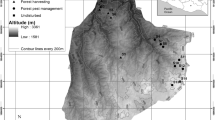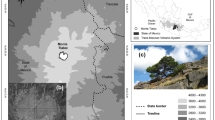Abstract
We monitored the recruitment, survival, and growth of tree saplings on invasive (Larix kaempferi) versus native species (Betula and Populus) using 16 20 m × 20 m plots established along elevation gradient on the volcano Mount Koma, Japan, for 7 years because the sapling behaviors should determine forest structures. The crowding of overstory consists mostly of Larix decreased with increasing elevation. Larix recruits were conspicuous, particularly at middle elevation where overstory crowding was intermediate, while Betula recruits were least. Larix overstory crowding inhibited the recruitment of all the taxa, although intermediate crowding promoted the recruitment of Larix. The restriction of sapling emergence was conspicuous at lower elevation where the overstory crowding was highest, probably because of shading, and/or competition with overstory trees. Sapling recruitment for all taxa was restricted at higher elevation, due to high stresses derived from direct solar radiation and strong wind without overstory. The survival of saplings was 96% for Larix and Betula, while it was ca. 50% for Populus. Larix overstory decreased the survival and growth of all the taxa, except Larix survival and Betula growth. The results implied that Larix could establish by high survival once the recruits succeeded everywhere and native sapling regeneration was restricted by Larix overstory. Strong recruitment, survival, and growth of Larix, together with resistance to overstory crowding, enables it to dominate and persist in such disturbed areas regardless of the canopy closure.


Similar content being viewed by others
References
Akasaka M, Tsuyuzaki S (2005) Tree seedling performance in microhabitats along elevational gradient on Mount Koma, Japan. J Veg Sci 16:647–654. doi:10.1658/1100-9233(2005)016[0647:TSPIMA]2.0.CO;2
Akasaka M, Tsuyuzaki S, Hase A (2007) Annual growth of invasive Larix kaempferi seedlings with reference to microhabitat and ectomycorrhizal colonization on a volcano. J Plant Res 120:329–336. doi:10.1007/s10265-006-0052-1
Burnham PB, Anderson DR (1998) Model selection and multimodel inference: a practical information-theoretic approach. Springer-Verlag, New York
Callaway RM, Brooker RW, Choler P, Kikvidze Z, Lortie CJ, Michalet R et al (2002) Positive interactions among alpine plants increase with stress. Nature 417:844–848. doi:10.1038/nature00812
Chen HYH, Legare S, Bergeron Y (2004) Variation of the understory composition and diversity along a gradient of productivity in Populus tremuloides stands of northern British Columbia, Canada. Can J Bot 82:1314–1323. doi:10.1139/b04-086
Clark JS, Beckage B, Camill P, Cleveland B, HilleRisLambers J, Lighter J, McLachlan J, Mohan J, Wyckoff P (1999) Interpreting recruitment limitation in forests. Am J Bot 86:1–16. doi:10.2307/2656950
Clark DB, Clark DA, Rich PM, Weiss S, Oberbauer SF (1996) Landscape scale evaluation of understory light and canopy structure: methods and application in a neotropical lowland rain forest. Can J Res 26:747–757. doi:10.1139/x26-084
Dolezal J, Ishii H, Vetrova VP, Sumida A, Hara T (2004) Tree growth and competition in a Betula platyphylla-Larix cajanderi post-fire forest in central Kamchatka. Ann Bot (Lond) 94:333–343. doi:10.1093/aob/mch149
Dullinger S, Dirnbock T, Kock R, Hochbichler E, Englisch T, Sauberer N et al (2005) Interactions among tree-line conifers: differential effects of pine on spruce and larch. J Ecol 93:948–957. doi:10.1111/j.1365-2745.2005.01036.x
Fleiss JL, Levin B, Paik MC (2003) Statistical methods for rates and proportions, vol 3rd. Wiley, Hoboken
Forest Agency of Japan (1976) Fundamental map of forest in Oshima-Hiyama. 1:5000, Forest Agency of Japan at Hakodate Branch, Hokkaido
Gómez-Aparicio L, Canham CD, Martin PH (2008) Neighbourhood models of the effect of the invasive Acer platanoides on tree seedling dynamics: linking impacts on communities and ecosystems. J Ecol 96:78–90
He FL, Duncan RP (2000) Density-dependent effects on tree survival in an old-growth Douglas fire forest. J Ecol 88:676–688. doi:10.1046/j.1365-2745.2000.00482.x
Hierro JL, Villarreal D, Eren O, Graham JM, Callaway RM (2006) Disturbance facilitates invasion: the effects are stronger abroad than at home. Am Nat 168:144–156. doi:10.1086/505767
Kueffer C, Schumacher E, Fleischmann K, Edwards PJ, Dietz H (2007) Strong below-ground competition shapes tree regeneration in invasive Cinnamonum verum forests. J Ecol 95:273–282. doi:10.1111/j.1365-2745.2007.01213.x
Kobe RK (1999) Light gradient partitioning among tropical tree species through differential seedling mortality and growth. Ecology 80:187–201
Kobe RK, Coates KD (1997) Models of sapling mortality as a function of growth to characterize interspecific variation in shade tolerance of eight tree species of northwestern British Columbia. Can J Res 27:227–236. doi:10.1139/cjfr-27-2-227
Kondo T, Tsuyuzaki S (1999) Natural regeneration patterns of the introduced larch, Larix kaempferi (Pinaceae), on the volcano Mount Koma, northern Japan. Divers Distrib 5:223–233. doi:10.1046/j.1472-4642.1999.00056.x
Landhausser SM, Lieffers VJ (2001) Photosynthesis and carbon allocation of six boreal tree species grown in understory and open conditions. Tree Physiol 21:243–250
Levine JM, Vila M, D’Antonio CM, Dukes JS, Grigulis K, Lavorel S (2003) Mechanisms underlying the impacts of exotic plant invasions. P Roy Soc B-Biol Sci 270:775–781
Martin TG, Wintle BA, Rhodes JR, Kuhnert PM, Field SA, Low-Choy SJ et al (2005) Zero tolerance ecology: improving ecological inference by modeling the source of zero observations. Ecol Lett 8:1235–1246. doi:10.1111/j.1461-0248.2005.00826.x
Mori A, Takeda H (2003) Light-related competitive effects of overstory trees on the understory conifer saplings in a subalpine forest. J For Res 8:163–168. doi:10.1007/s10310-002-0022-y
Myers JH, Bazely DR (2003) Ecology and control of introduced plants. Cambridge University Press, Cambridge
Nagaike T (2002) Differences in plant species diversity between conifer (Larix kaempferi) plantations and broad-leaved (Quercus crispula) secondary forests in central Japan. For Ecol Manage 168:111–123
Nakamura T (1985) Forest succession in the subalpine region of Mt. Fuji, Japan. Vegetatio 64:15–27. doi:10.1007/BF00033450
Nathan R, Ne’eman G (2004) Spatiotemporal dynamics of recruitment in Aleppo pine (Pinus halepensis Miller). Plant Ecol 171:123–137. doi:10.1023/B:VEGE.0000029379.32705.0f
Niinemets U, Kull O (1999) Biomass investment in leaf lamina versus lamina support in relation to growth irradiance and leaf size in temperate deciduous trees. Tree Physiol 19:349–358
Nishi H, Tsuyuzaki S (2004) Seed dispersal and seedling establishment of Rhus trichocarpa promoted by a crow (Corvus macrorhynchos) on a volcano in Japan. Ecography 27:311–327. doi:10.1111/j.0906-7590.2004.03737.x
Ohwi J (1975) Flora of Japan (rev. ed.). Shibundo, Tokyo, Japan
Peterken GF (2001) Ecological effects of introduced tree species in Britain. For Ecol Manage 141:31–42
R Development Core Team (2004) R: a language and environment for statistical computing. R Foundation for Statistical Computing, Vienna
Reinhart KO, Greene E, Callaway RM (2005) Effects of Acer platanoides invasion on understory plant communities and tree regeneration in the northern rocky mountains. Ecography 28:573–582. doi:10.1111/j.2005.0906-7590.04166.x
Reinhart KO, Gurnee J, Tirado R, Callaway RM (2006a) Invasion through quantitative effects: intense shade drives native decline and invasive success. Ecol Appl 16:1821–1831. doi:10.1890/1051-0761(2006)016[1821:ITQEIS]2.0.CO;2
Reinhart KO, Maestre FT, Callaway RM (2006b) Facilitation and inhibition of seedlings of an invasive tree (Acer platanoides) by different tree species in a mountain ecosystem. Biol Invasions 8:231–240. doi:10.1007/s10530-004-5163-9
Rejmánek M, Richardson DM (1996) What attributes make some plant species more invasive? Ecology 77:1655–1661. doi:10.2307/2265768
Richardson DM, Rejmánek M (2004) Conifers as invasive aliens: a global survey and predictive framework. Divers Distrib 10:321–331. doi:10.1111/j.1366-9516.2004.00096.x
Rooney TP, McCormick RJ, Solheim SL, Waller DM (2000) Regional variation in recruitment of hemlock seedlings and saplings in the upper Great Lakes, USA. Ecol Appl 10:1119–1132. doi:10.1890/1051-0761(2000)010[1119:RVIROH]2.0.CO;2
Schulze ED, Beck E, Muller HK (2005) Plant ecology. Springer, Berlin
Šrutek M, Lěps J (1994) Variation in structure of Larix olgensis stands along the altitudinal gradient on Paektu-san, Changbai-shan, North Korea. Arct Alp Res 26:166–173. doi:10.2307/1551780
Stoll P, Weiner J, Schmid B (1994) Growth variation in a naturally established population of Pinus sylvestris. Ecology 75:660–670. doi:10.2307/1941724
Titus JH, Tsuyuzaki S (2003) Influence of a non-native invasive tree on primary succession at Mt Koma, Hokkaido, Japan. Plant Ecol 169:307–315. doi:10.1023/A:1026081910749
Tsuyuzaki S, Hase A, Niinuma H, Hanada Y (2000) List for seed plants on Mount Koma, Hokkaido, in 2000. Biol Mater 36:1–6
Uesaka S, Tsuyuzaki S (2004) Differential establishment and survival of species in deciduous and evergreen shrub patches and on bare ground, Mt. Koma, Hokkaido, Japan. Plant Ecol 175:165–177. doi:10.1007/s11258-005-4839-2
Wearne LJ, Morgan JW (2004) Community-level changes in Australian subalpine vegetation following invasion by the non-native shrub Cytisus scoparius. J Veg Sci 15:595–604. doi:10.1658/1100-9233(2004)015[0595:CCIASV]2.0.CO;2
Yurkonis KA, Meiners SJ (2004) Invasion impacts local species turnover in a successional system. Ecol Lett 7:764–769. doi:10.1111/j.1461-0248.2004.00636.x
Acknowledgments
We thank Y. Yamada, S. Uesaka, A. Hirao, S. Kosuge and all the members in REL, GSEES, HU, for field assistances, and two anonymous reviewers for their comments to improve the manuscript. We thank K. Nakanishi, the Public Office of Mori Town, for support on the field survey. This work is partly supported by the grants from Ministry of Science, Education, and Culture of Japan, and Japan Society for the Promotion of Science.
Author information
Authors and Affiliations
Corresponding author
Rights and permissions
About this article
Cite this article
Akasaka, M., Tsuyuzaki, S. Comparisons of recruitment, survival, and growth in invasive and native saplings on a volcano. Plant Ecol 202, 235–245 (2009). https://doi.org/10.1007/s11258-008-9464-4
Received:
Accepted:
Published:
Issue Date:
DOI: https://doi.org/10.1007/s11258-008-9464-4




